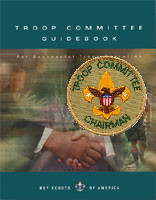 At a recent troop meeting we were welcoming a parent of a boy new to Scouting and discussing how the troop and Boy Scouts all works, and in the process of explaining which committee member takes care of dues, or membership, he asked me what my position was, and what I do in the troop.
At a recent troop meeting we were welcoming a parent of a boy new to Scouting and discussing how the troop and Boy Scouts all works, and in the process of explaining which committee member takes care of dues, or membership, he asked me what my position was, and what I do in the troop.
This kind of took me aback, because most people in Scouting are familiar with the committee chair’s role, or at least knows what functions he or she performs. I blurted out “well, I’m kind of like the CEO of the troop,” and while I felt at the time that it was an OK answer, later I thought that it didn’t really describe what the committee chair does.
The Troop Committee Guidebook lists among the committee chair’s responsibilities to conduct committee meetings, keep in touch with the chartered organization, interpret national and local policies, ensure the troop has qualified leadership, and renew the charter annually. Despite this list of responsibilities, I’ve always felt that the number one item in any job description should be “all other duties as assigned.” After all, how much time do we spend on the items in the list, and how often do we end up doing all those miscellaneous things that come our way?
On further thought, I came up with a better explanation of the things that the committee chair does:
- Try to ensure that everyone’s viewpoint is heard
- Take the blame for things that go wrong, whether it’s your fault or someone else’s, while calmly trying to resolve issues in a way that will best serve the boys and will save face for your committee members
- Not find fault, but find a solution
- Try to mediate disputes or disagreements between committee members so each comes away with a positive resolution
- Do everything you can to give the rest of the committee, and the Scoutmaster, what they need to do their job
- Fill in for the missing positions on the committee while you recruit replacements
- Make sure that your unit commissioner and district executive have a reliable point of contact
- Try to answer the many questions from the many adults who need to know things
- Try your best to send any boys who come to you with questions back to their youth leadership, rather than answering them yourself
- Try to keep other adults from answering the boys’ questions, cleaning up after them, teaching Scout skills, going inside the troop trailer, and otherwise getting in the middle of the boys’ business
- Recognize and reward the efforts of the many adult volunteers without whose participation the Scouting program just would not happen
As you can see, it’s not just the line items in the Guidebook that define the committee chair’s role. You may be in the job for several years before encountering some of them, while others you’ll run into almost every week. Time and a positive attitude will help you learn to deal with them.
I’m sure you can grow this list from your own experiences. Feel free to leave a comment and add your thoughts.
This post first appeared on Bobwhite Blather.



I agree. I’ve always said that “the Scoutmaster and the Committee Chair do everything. How would you like to help?” The result of this attitude is that volunteers come on and agree to work at something that they actually want to do. So I try real hard not to have an Advancement Chair working as a Treasurer. Once people take on something they like to do they often stay at it for many years. This produces stability in the Troop.
In a new or rebuilding Troop this can place some stress on these two people, but if they stick with it, the reward can be great. My CC was the treasurer for a while (and some other stuff). We kept getting new folks volunteering but no treasurer. Then one day the exact right guy showed up. He was treasurer for the entire seven years his son was in the Troop. He never lost a penny and had the greatest reports each month at committee meeting. He provided a really good transition for the person that followed him. Really good guy.
Taking the blame is amazingly effective at resolving heated issues. I’ve done that a few times. People are either relieved that it is over or a bit embarrassed because they were part of the problem. Either way, the group is already in a better place.